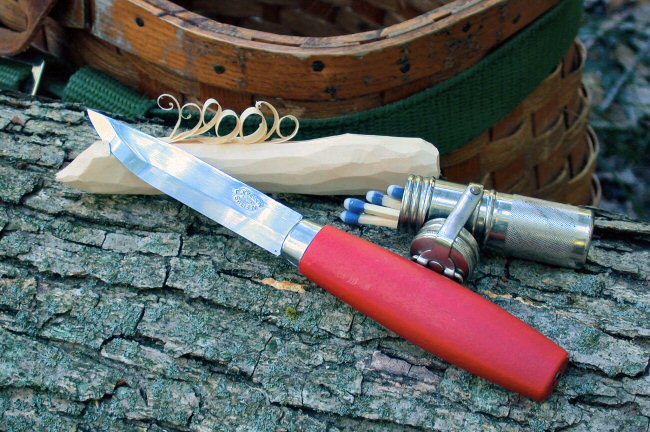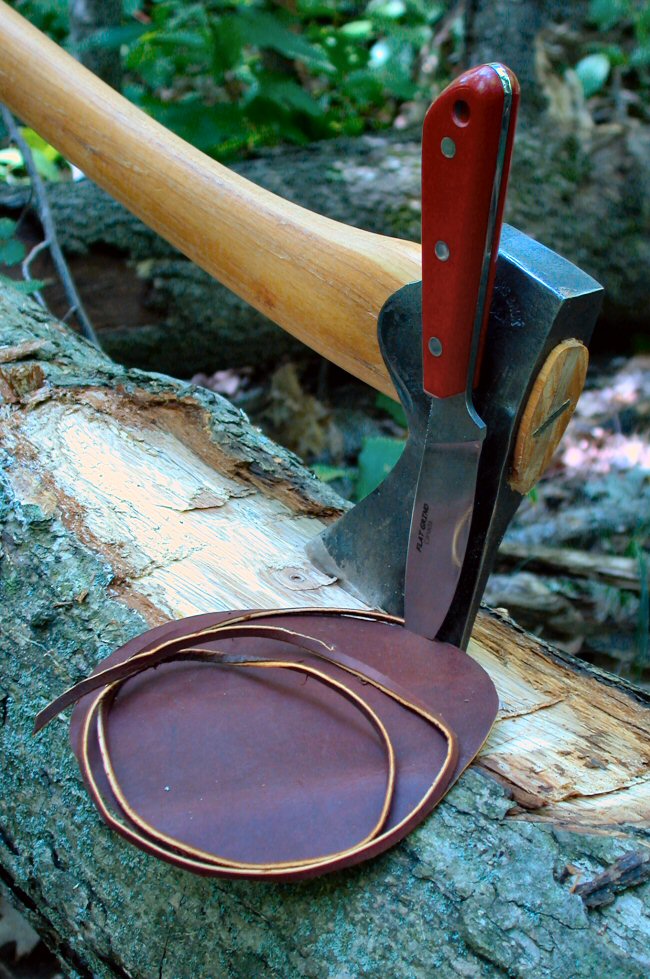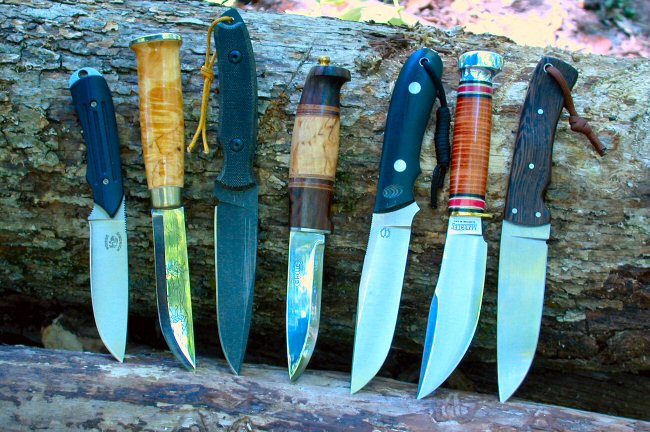Choosing an Outdoorsman’s Knife
Dr. Terry M. Trier
The outdoorsman’s knife, by its very name, conjures up images of those who would wield such blades. Rugged, independent individuals of a bygone era, clad in wool shirts and trousers, perhaps wearing wide-brimmed felt hats. Canoeing, hunting, fishing, pathfinding, and campcraft were their stock and trade, plied in the northwoods or southern mountains and wooded valleys of North America. They were at home in the outdoors, living there for weeks or even months at a time, camping in a trackless wilderness, summer or winter, and thriving in comfort under conditions less adventurous souls considered intolerable. Perhaps they were trappers, prospectors, guides, naturalists, or timber cruisers, or just hardy, adventurous individualists, filled with wanderlust and fleeing the crowded cities in search of a rapidly vanishing frontier. Whatever their provenance, it is clear that they were highly skilled in the outdoors, and could survive in wilderness for extended periods of time while traveling with only the most basic of tools, the outdoorsman’s knife being one of their most prized possessions.
When we talk of an outdoorsman’s knife, we are generally referring to a fixed-blade knife, although it is clear that this was not the only edged tool the outdoorsmen of yesteryear carried. Most outdoorsmen–often referred to as woodsmen–also carried some kind of a jack knife, an axe and a saw. Many also carried something called a “crooked knife,” which is a knife with a curve in it that is used for woodcarving. Additionally, a firearm–usually a rifle–and some fishing gear were essential elements of their kit. With these sophisticated tools of the trade, food, shelter, and comfort were easily obtained by the experienced woodsman. Note that most of these individuals likely could have survived with much less and many were well-schooled in the so-called “primitive” technology of indigenous peoples. But they were practical in their habits and valued what technology was available at the time to enhance their comforts in the wild. This was also a day and age of Abercrombie and Fitch, which, for the greater part of the 20th century, specialized in providing professional outdoorsmen with the finest outdoor gear available, from tents to double-barreled rifles. Theodore Roosevelt, Robert Peary, Ernest Hemingway, and many other famous sportsmen bought hunting, fishing, and camping equipment from Abercrombie and Fitch, and outdoor sportsmen in general usually had access to well-made equipment, including edged tools.
 |
| Woodsmen rely on their knives for critical tasks. The ability to make dry tinder by shaving fine curls on a piece of wood–the so-called fuzz stick–could be essential for starting a fire during prolonged wet spells. The Swedish Mora, with its single bevel grind, is well designed for the job. |
Although dignitaries like Roosevelt and Hemingway are familiar to us all, the most skilled outdoorsmen of the late 19th and early 20th century were not as famous but often well-known by sportsmen through the magazine articles and books they wrote that heavily influenced a generation of wilderness travelers during the 20th century. The three most notable are Nessmuk (George Washington Sears), Horace Kephart, and Calvin Rutstrum, all of whom have books still in print, a true testimonial not only to their wonderful writing skills, but also to the endurance of their outdoor wisdom. Both Nessmuk and Kephart were true “turn of the century” outdoorsmen, while Rutstrum, born in 1895, was a more “modern” outdoorsman, and this is reflected in the title of one of his many books, The New Way of the Wilderness, first published in 1958. Still, much of Rutstrum’s methods differed little from those practiced by Nessmuk and Kephart. And one can readily see this by looking at the characteristics they deemed important for selecting an outdoorsman’s knife.
One of the ways we can characterize on outdoorsman’s knife is by what it isn’t. Nessmuk, in Woodcraft and Camping wrote: “A word as to knife or knives. These are of prime necessity, and should be of the best, both as to shape and temper. The “bowies” and “hunting knives” usually kept on sale, are thick, clumsy affairs, with a sort of ridge along the middle of the blade, murderous-looking, but of little use; rather fitted to adorn a dime novel of the belt of “Billy the Kid,” than the outfit of the hunter.”
Kephart, a great admirer of Nessmuk, echoed his sentiments in his classic book on the outdoors, Camping and Woodcraft: “The conventional hunting knife is, or was until recently, of the familiar dime-novel pattern invented by Colonel Bowie. It is too thick and clumsy to whittle with, much too thick for a good skinning knife, and too sharply pointed to cook and eat with. It is always tempered too hard. When put to the rough service for which it is supposed to be intended, as in cutting through the ossified false ribs of an old buck, it is an even bet that out will come a nick as big as a saw-tooth –and Sheridan forty miles from a grindstone!” Rutstrum was also a fan of thin-bladed knives and wrote the following in his book Paradise Below Zero: “Avoid the thick, chisel-edged knife. The most efficient blade has a flat, continuous grind from edge to spine, the blade not too thick.” Rutstrum was especially fond of the Marbles “Expert,” the original version of this knife being ground from fairly thin stock. Kephart favored the Marbles Woodcraft pattern, while Nessmuk’s knife was similar, but with a rounded hump on the spine an inch or so back from the tip, convenient for gutting a large game animal without cutting the viscera.
 |
| The outdoorsman’s knife has to be versatile. This Grohmann Boat Knife, with it’s thin razor edge, combined with a Gransfors Bruks Small Forest Axe, makes it easy in the field to cut leather laces or straps from a hunk of leather. |
In general, then, the “old timey” outdoorsmen favored a thin bladed knife
for every-day carry. It was not the thick bladed “chopper” so often promoted
as a survival knife by many survival buffs today. For chopping, the woodsmen
favored a hatchet or axe. The outdoorsman’s knife was reserved as a fine
cutting instrument and had to be capable of doing a variety of tasks in the
field such as slicing bread, vegetables and meat, field dressing and
butchering large and small game, and woodcraft. Most also preferred a knife
of carbon steel that was lightweight, tempered hard but not brittle, held a
good edge, but was still soft enough for quick and easy sharpening in the
field.
Much has changed since the days of Nessmuk. New, high-quality stainless steels and sophisticated heat treating and cryogenic tempering have led to a wider assortment of high quality knife blades to choose from. But the basic fundamentals in knife design are still often preferred by many modern outdoorsmen.
For example, Cliff Jacobson, a well-known northwoods canoeist and outdoorsman, wrote the following in 1987 in his book, Camping’s Top Secrets: “Nearly all knives sold for outdoor use have blades which are too thick. One-eighth of an inch across the spine is the maximum thickness permissible for a utility knife, no matter how delicate the edge. Try slicing a tomato with the typical “hunting” knife and you’ll see why!” Wilderness survival experts like Mors Kochanski and Ray Mears prefer thin-bladed knives of Scandinavian design. They are usually ground with a single wide bevel, making them excellent wood carving knives. Kochanski prefers a blade that is “from two and a half to three millimetres thick and about two to two and a half centimetres wide.” Kochanski often carries an inexpensive Swedish Mora as his blade of choice. Like the outdoorsmen of yesteryear, both Kochanski and Mears prefer short blades not exceeding six inches.
 |
| Some of the author’s favorite thin-bladed knives for outdoor use: From left to right: Camillus Simonich Talon, Marttiini Lapinleuku, Gerber Yari, Helle Harding, Dozier Professional Guides Knife, Marbles Woodcraft, Chang Wenge Hunter. |
No matter what kind of knife you decide to carry when you are traveling in
the outdoors, it is important to consider carefully the kinds of activities
you will be pursuing. Obviously, if you are hunting deer in a local wood
lot, you will prefer a knife optimized for field dressing. If you are
clearing trails or shooting lanes for hunting, a chopping blade of some type
may be in order. But if you are considering a trip into a remote wilderness,
where you often must travel light, and versatility is at a premium to
minimize weight, it may be worth your while to consider carefully the advice
of the early outdoorsmen who traveled regularly and extensively in the wilds
of North America. As long as there are vast tracts of wilderness still
available for exploring, most of what they had to say is still relevant for
the outdoorsmen of today and tomorrow.
©2002 Terry M. Trier